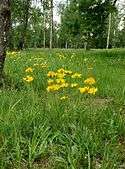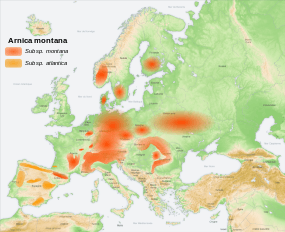Arnica montana
| Arnica montana | |
|---|---|
 | |
| 1897 illustration[1] | |
| Scientific classification | |
| Kingdom: | Plantae |
| (unranked): | Angiosperms |
| (unranked): | Eudicots |
| (unranked): | Asterids |
| Order: | Asterales |
| Family: | Asteraceae |
| Genus: | Arnica |
| Species: | A. montana |
| Binomial name | |
| Arnica montana L. | |
| Synonyms[2] | |
| |
Arnica montana, sometimes mistakenly referred to as wolf's bane, has also been called leopard's bane, mountain tobacco and mountain arnica,[3] is a European flowering plant in the sunflower family. It is noted for its large yellow flower head.

Description
Arnica montana is a flowering plant about 18–60 cm (7.1–23.6 in) tall aromatic fragrant, perennial herb. Its basal green ovate-cilitate leaves with rounded tips are bright coloured and level to the ground. In addition, they are somewhat downy on their upper surface, veined and aggregated in rosettes. By contrast, the upper leaves are opposed, spear-shaped and smaller which is an exception within the Asteraceae. The chromosome number is 2n=38.
The flowering season is between May and August (Central Europe). The hairy flowers are composed of yellow disc florets in the center and orange-yellow ray florets at the external part. The achenes have a one-piece rough pappus which opens in dry conditions.[4][5] Arnica montana is a hemicryptophyte,[6] which helps the plant to survive the extreme overwintering condition of its habitat. In addition, Arnica forms rhizomes, which grow in a two-year cycle: the rosette part grows at its front while its tail is slowly dying.[7]

Distribution and habitat
Arnica montana is widespread across most of Europe.[8] It is absent from the British Isles and the Italian and Balkan peninsulas and Slovakia.[9] In addition, it is considered extinct in Hungary and Lithuania.[9] Arnica montana grows in nutrient-poor siliceous meadows or clay soils.[7] It mostly grows on alpine meadows and up to nearly 3,000 m (9,800 ft). In more upland regions, it may also be found on nutrient-poor moors and heaths. However Arnica does not grow on lime soil,[7] thus it is an extremely reliable bioindicator for nutrient poor and acidic soils. It is rare overall, but may be locally abundant. It is becoming rarer, particularly in the north of its distribution, largely due to increasingly intensive agriculture and commercial wild-crafting.[10] Nevertheless, it is cultivated on a large scale in Estonia.[9]
Chemical constituents

The main constituents of Arnica montana are essential oils, fatty acids, thymol, pseudoguaianolide sesquiterpene lactones and flavanone glycosides. Pseudoguaianolide sesquiterpenes constitute 0.2-0.8 % of the flower head of Arnica montana. They are the toxin helenalin and their fatty esters.[11]
Cultivation
Arnica montana is propagated from seed. Generally, 20% of seeds do not germinate. For large scale planting, it is recommended to raise plants first in a nursery and then to transplant them in the field. Seeds sprout in 14–20 days but germination rate depends highly of the seed quality. Planting density for Arnica montana is of 20 plants/m2 such that the maximum yield density will be achieved in the second flowering season. While Arnica montana has high exigencies of soil quality, analyses should be done before any fertilizer input.[12]
The flowers are harvested when fully developed and dried without their bract nor receptacles. The roots can be harvested in autumn and dried as well after being carefully washed.[7]
Arnica montana is sometimes grown in herb gardens.[13]
Medicinal use
Historically has been used as an herbal medicine.[13][14] It has been used in herbal medicine for centuries.[15]
Clinical trials of Arnica montana have yielded mixed results:
- When used topically in a gel at 50% concentration, A. montana was found to have the same effect when compared to a 5% ibuprofen gel for treating the symptoms of hand osteoarthritis.[16]
- A scientific study by FDA funded dermatologists found that the application of topical A. montana had no better effect than a placebo in the treatment of laser-induced bruising.[17]
- In 1998, a systematic review of homeopathic A. montana at the University of Exeter concluded that there are no rigorous clinical trials that support the claim that it is efficacious beyond a placebo effect.[18]
- A 2013 Cochrane Collaboration systematic review of topical herbal remedies for treating osteoarthritis concluded that "Arnica gel probably improves pain and function as well as non-steroidal anti-inflammatory drugs do."[19]

Toxicity
A. montana contains the toxin helenalin, which can be poisonous if large amounts of the plant are eaten. It produces severe gastroenteritis and internal bleeding of the digestive tract if enough material is ingested.[20] Contact with the plant can also cause skin irritation.[21][22]
Market
The demand for A. montana is 50 tonnes per year in Europe, but the supply does not cover the demand. The plant is rare; it is protected in Belgium, France, Germany, Italy, Poland, and in some regions of Switzerland. France and Romania produce A. montana for the international market.[23] Changes in agriculture in Europe during the last decades have led to a decline in the occurrence of A. montana. Extensive agriculture has been replaced by intensive management.[24]
References
- ↑ illustration from Franz Eugen Köhler, Köhler's Medizinal-Pflanzen, 1897
- ↑ The Plant List Arnica montana L.
- ↑ Judith Ladner. "Arnica montana". Food and Agriculture Organization. Archived from the original on February 13, 2010. Retrieved March 16, 2010.
- ↑ Arnica montana L., relevant European medical plant (2014). Waizel-Bucay J., Cruz-Juarez M. de L. Revista Mexicana de Ciencias Forestales, Vol. 5 Issue 25 p. 98-109
- ↑ http://www2.ufz.de/biolflor/taxonomie/taxonomie.jsp?ID_Taxonomie=286
- ↑ "FloraWeb: Daten und Informationen zu Wildpflanzen und zur Vegetation Deutschlands". www.floraweb.de. Retrieved 2015-11-25.
- 1 2 3 4 Hofmann, Maria. Heilmittel der Natur Arnika. Südwest. ISBN 3-517-08019-5.
- ↑ "Arnica montana [Arnica]". luirig.altervista.org. Retrieved 2015-11-26.
- 1 2 3 http://euromed.luomus.fi/euromed_map.php?taxon=416903&size=medium
- ↑ M. Finlay, Sandra. Advance home remedies. ask1on.
- ↑ WHO Monographs of selected medicinal plants volume 3
- ↑ B.M.Smallfield & M.H. Douglas (2008) Arnica montana a grower‟s guide for commercial production in New Zealand. New Zealand Institute for Crop and Food Research Limited
- 1 2 "Arnica". Flora of North America. efloras.org. Archived from the original on April 4, 2010. Retrieved March 16, 2010.
- ↑ A. L. Butiuc-Keul; C. Deliu (2001). "Clonal propagation of Arnica montana L., a medicinal plant". In Vitro Cellular and Development Biology – Plant. 37 (5): 581–585. doi:10.1007/s11627-001-0102-2. JSTOR 4293517.
- ↑ Knuesel, O.; Weber, M.; Suter, A. (2002). "Arnica montana gel in osteoarthritis of the knee: An open, multicenter clinical trial". Advances in Therapy. 19 (5): 209–218. doi:10.1007/BF02850361. PMID 12539881.
- ↑ R. Widrig; A. Suter; R. Saller & J. Melzer (2007). "Choosing between NSAID and arnica for topical treatment of hand osteoarthritis in a randomised, double-blind study". Rheumatology International. 27 (6): 585–91. doi:10.1007/s00296-007-0304-y. PMID 17318618.
- ↑ Delilah Alonso; Melissa C. Lazarus & Leslie Baumann (2002). "Effects of topical arnica gel on post-laser treatment bruises". Dermatologic Surgery. 28 (8): 686–8. doi:10.1046/j.1524-4725.2002.02011.x. PMID 12174058. Retrieved January 27, 2008.
- ↑ Ernst, E.; Pittler, M. H. (1998). "Efficacy of Homeopathic Arnica". Archives of Surgery. 133 (11): 1187–90. doi:10.1001/archsurg.133.11.1187. PMID 9820349.
- ↑ "Topical herbal therapy for treating osteoarthritis | Cochrane". www.cochrane.org. Retrieved 2015-07-08.
- ↑ Gregory L. Tilford (1997). Edible and Medicinal Plants of the West. Mountain Press. ISBN 0-87842-359-1.
- ↑ "Poisonous Plants: Arnica montana". North Carolina State University.
- ↑ Rudzki E; Grzywa Z (October 1977). "Dermatitis from Arnica montana". Contact Dermatitis. 3 (5): 281–2. doi:10.1111/j.1600-0536.1977.tb03682.x. PMID 145351.
- ↑ Pasquier, B., Godin, M. (2014) L’arnica des montagnes, entre culture et cueillette. Dossier simple et aromatique, Jardins de France 630.
- ↑ Michler, B. (2007) Conservation of Eastern European Medicinal Plants Arnica Montana in Romania
External links
| Wikimedia Commons has media related to Arnica montana. |
- Royal Society of Medicine Article concerning testing involving Arnica (RSM)
- Botanical.com, a modern herbal Arnica
- "Arnica montana". Integrated Taxonomic Information System. Retrieved May 23, 2006.